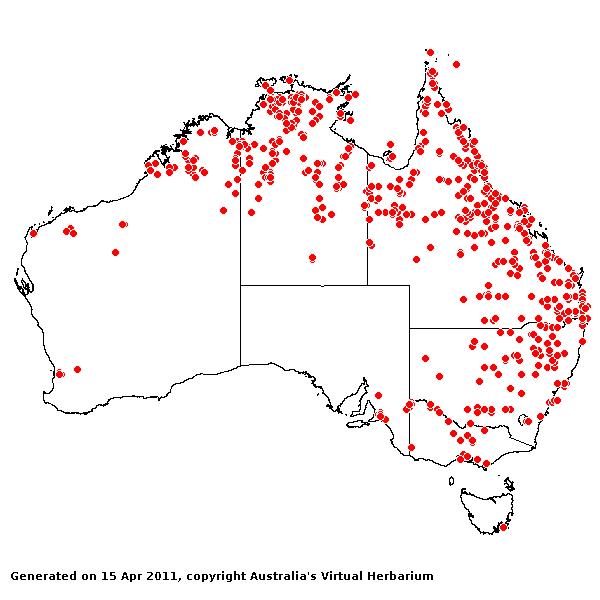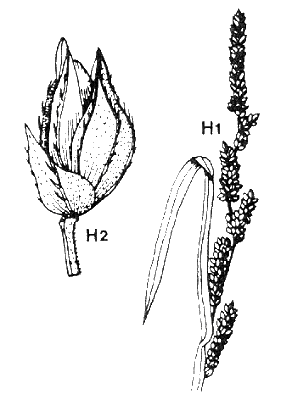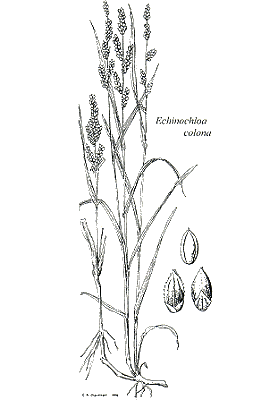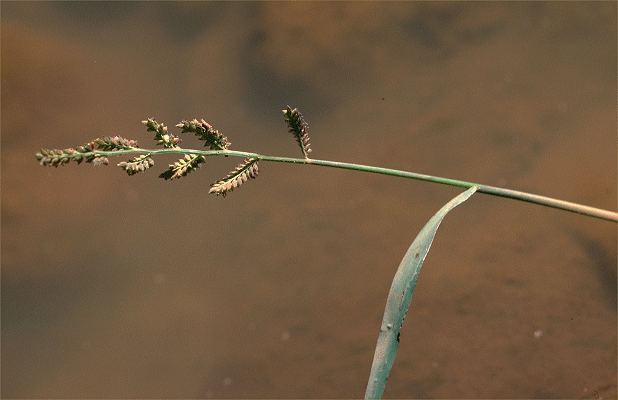Echinochloa colona* (L.) Link. Hort. Reg. Bot. Berol. 2: 209 (1833).
Classification. (GPWG 2001) : Subfamily Panicoideae. Paniceae.
Basionym and/or Replacement Name: Panicum colonum L., Syst. Nat. (ed. 10) 2: 870 (1759).
Type of Basionym or Protologue Information: LT: P. Browne s.n., Jamaica (LINN-80.23). LT designated by Clayton & Renvoize, Fl. Trop. East Afr., Gramineae (part 3): ? (1982); the typification by Hitchcock, Contr. U.S. Natl. Herb. 12: 119 (1908) was not effective.
Key references (books and floras): [1878] G.Bentham, Flora Australiensis 7 (478 as Panicum colonum), [1969] E.E.Henty, Manual Grasses New Guinea (81 as E. colonum), [1981] M.Lazarides in J.Jessop (ed)., Flora of Central Australia (476 as E. colonum), [2002] D.Sharp & B.K.Simon, AusGrass, Grasses of Australia, [2006] J.Jessop, G.R.M.Dashorst, F.M.James, Grasses of South Australia (445), [2008] S.W.L.Jacobs, R.D.B.Walley & D.J.B.Wheeler, Grasses of New South Wales (226).
Illustrations: [1952] C.A.Gardner, Flora of Western Australia 1 Gramineae (255, Pl. 75 as E. colonum), [2006] J.Jessop, G.R.M.Dashorst, F.M.James, Grasses of South Australia (445, Fig. 376), [2008] S.W.L.Jacobs, R.D.B.Whalley & D.J.B.Wheeler, Grasses of New South Wales, 4th edn (226).
Habit. Annual. Rhizomes absent. Stolons absent or present. Culms erect or geniculately ascending or decumbent, 10–100 cm tall, 3–8 -noded. Leaf-sheaths glabrous on surface. Ligule absent. Leaf-blades 3–30 cm long, 2–8 mm wide. Leaf-blade surface smooth.
Inflorescence. Inflorescence compound, a panicle of racemes. Racemes ascending (rarely) or appressed, 0.5–3 cm long. Central inflorescence axis 1–15 cm long.
Spikelets. Spikelets sessile, 2–4 in the cluster. Fertile spikelets 2-flowered, the lower floret barren (rarely male), the upper fertile, comprising 1 basal sterile florets, comprising 1 fertile floret(s), without rachilla extension, elliptic or ovate or orbicular, dorsally compressed, 1.5–3 mm long. Rhachilla internodes brief up to lowest fertile floret.
Glumes. Glumes dissimilar, thinner than fertile lemma. Lower glume ovate, membranous, without keels, 3–5 -nerved. Lower glume apex muticous or mucronate. Upper glume ovate, 2.2–2.8 mm long, membranous, without keels, 5 -nerved. Upper glume surface indumented. Upper glume apex mucronate. Florets. Basal sterile florets 1, male or barren, with palea. Lemma of lower sterile floret 100 % of length of spikelet, membranous, 5 -nerved.
Fertile lemma 1.9–3 mm long, without keel, 5 -nerved. Anthers 3. Grain 1.5–2 mm long.
Continental Distribution: Europe, Africa, Temperate Asia, Tropical Asia, Australasia, Pacific, North America, and South America.
Australian Distribution: Western Australia, Northern Territory, South Australia, Queensland, New South Wales, Victoria, Christmas Is.
Western Australia: Gardner, Fitzgerald, Dampier. Canning, Fortescue. Northern Territory: Darwin & Gulf, Victoria River, Central Australia North. South Australia: Northern Lofty, Murray, Southern Lofty, South-eastern. Queensland: Burke, Burnett, Cook, Darling Downs, Leichhardt, Maranoa, Mitchell, Moreton, North Kennedy, Port Curtis, South Kennedy, Warrego, Wide Bay. New South Wales: North Coast, Central Coast, North-Western Slopes, Central-Western Slopes, North-Western Plains, South-Western Plains. Victoria: Gippsland Plain, Murray Mallee, Riverina, Volcanic Plain.
Notes. Morphologically variable and tends to intergrade with other species. Diagnostic features of E. colona include spikelet length, length of the upper floret, awnless spikelets and the arrangement of the spikelets in 4 uniform rows on the primary branches.
Introduced. In tropical and subtropical rain forests, Brigalow forests, tropical and subtropical sub-humid woodlands, temperate sub-humid woodlands, semi-arid shrub woodlands, arid and semi-arid low woodlands, acacia shrublands, arid tussock grasslands, and coastal grasslands. Occurs throughout the tropics. Flowers sporadically throughout the year.








